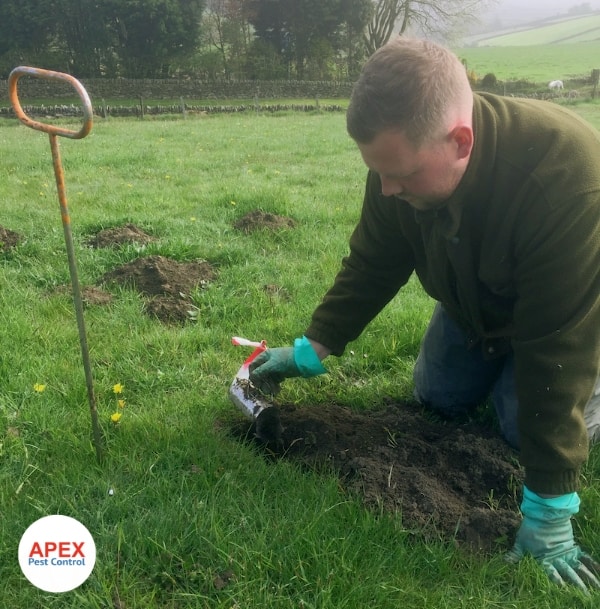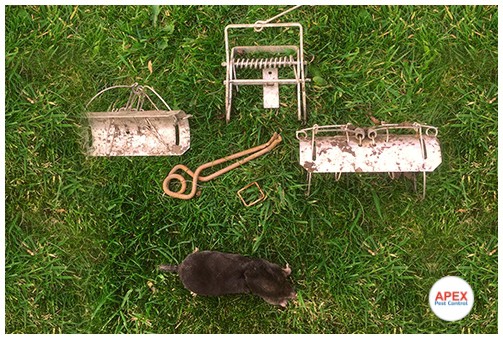Mole Control
We search and get rid of moles from your property. Using our experience and the best products, we keep your ground and lawn safe. Our mole control services are designed for homeowners and commercial business.
- Open 7 Days a Week
- National Pest Technicians Association (NPTA)
- Proven Mole Control Methods
- Members of the British Mole Catchers Register (BMCR)

5 Reasons for Mole Pest Control
- Where the grass gets grown for silage, this rapidly deteriorates if contaminated by the earth from molehills. The area of the molehill prevents grass from growing and allows weeds to grow, leading to rapid deterioration of pastureland.
- Stones brought to the surface by moles can damage the cutter bars of mowing machines and harvesters.
- Moles working under the roots of crops can cause the plants to either have stunted growth or to die due to soil drying out.
- On racecourses or gallops, the presence of moles is a danger to horse and rider.
- On lawns, playing fields or golf courses, they disfigure the areas, allowing weeds to become established.
Methods of Controlling Moles
There are two main methods of mole control that pest control companies will use; these are either:
- Trapping
- Gassing.
Due to gassing being, in our opinion, only 60-70% successful, and potentially highly dangerous sustenance, at Apex Pest Control, we as a company will catch moles. Catching moles has the advantage of showing you our success rate by the physically found mole.

Trapping the Moles
We use four types of traps:
- Putange Trap
- Duffus Tunnel Trap
- Scissor Trap
- Talpex Trap
To suit individual situations and soil types. These are placed between molehills in the tunnel system and marked with small flags for location later. We re-visit within 12-24 hours of traps being set and re-inspect all traps for either the pest caught in the traps or disturbance at the trap.
As a mole trapper, we don’t finish until all moles get caught. Once we have captured all the moles, one or two further visits will be carried out to search for activity and make sure no more moles are in the runs.

How Much is Pest Control for Moles?
For garden mole control prices we charge for pest control trapping by use of a set rate of £135 (cost includes 3 visits) in gardens and small paddocks. Our pests methods are natural repellents to protect your garden lawns and plants. This is the best way of how to get rid of moles in garden.
The cost of effective control for farms or vast acres is by price per mole caught. Our professional pests control will stop the underground damage and holes that moles cause once they get on your land.
Our Price Guarantee
Our policy is no moles caught we do not charge. If any mole activity is found within 14 days of us finishing our trapping service, we will trap free of charge until the problem pests get resolved.
Call a Pest Control Expert on 0114 3491098
Mole Activity and Tunnelling Systems
Moles tend to be solitary by nature and spend the majority of their lives in the tunnel network. These are complex tunnels of permanent or temporary tunnels.
The moles will construct these tunnels using its spade-like forepaws. A mole digs its burrows with other front paws, holding its body against the tunnel walls with its back limbs. The soil is moved behind the mole’s body. Once there is a suitable amount of dirt, the mole turns in the tunnel and pushes the earth to the surface, creating a new molehill or contributing to an existing one.
Two types of tunnels get created: surface tunnels and deep tunnels.
- Surface Tunnels – visible as a raised ridge of soil, and is common in newly cultivated soil and light, sandy soil. These are temporary structures and should not be used for trapping or baits.
- Deep Tunnels – This is the primary system used by the mole to create a nest site in the breeding season and an area to catch earthworms and other invertebrates.
Garden Fortresses – From time to time amongst mole hills, a far larger molehill will appear. You find the larger molehill is usually in areas which are liable to flooding. In areas subject to flooding, the ‘fortress’ will give a retreat. The mole’s nest will be dry, and stores of worms will sustain the mole until the waters recede.
In shallow soils where moles are forced to sleep near the surface, the ‘fortress’ will insulate the nest from cold.
Food Source
The leading food of the mole is the earthworm. Moles do however search for and consume other soil invertebrates, particularly insect larvae and grubs.
Most of the mole’s food is found in the tunnel systems. The mole regularly patrols the tunnels; the mole feeding and sleeping patterns are roughly four hours. If there is a significant food source, earthworms are immobilised by a bite to the head, and they get stored until needed.
Moles are active all year round, and you will see them more in spring and don’t hibernate.
The Mole Breeding Season
The breeding season starts in February and lasts to June in spring. The gestation period is four weeks, and the young are born, blind and without fur. The mother feeds them for 4-5 weeks, and after this period, they leave the nest and catch food for themselves.
Shortly, they will leave the nest site and search for a home of their own. During this period, as they usually to move above ground, they are at their most vulnerable and fall victim to predators like birds.
How to get rid of Moles
When catching moles, we follow the industry guidelines, quality products and our experience catching moles. Taking care to find the pests without disrupting all wildlife nearby and minimise disturbance on your land. If you require services to control moles and looking for mole removal services near me, call us today!
Apex Pest Control is a trusted member of the British Mole Catcher Register.
Contact Us
- Apex Pest Control
- 54 Baxter Dr, Sheffield, S6 1GH
- Local Branch
Members of

Follow Us
